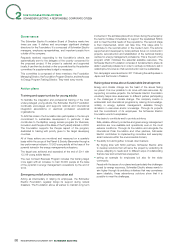APC 2011 Annual Report Download - page 86
Download and view the complete annual report
Please find page 86 of the 2011 APC annual report below. You can navigate through the pages in the report by either clicking on the pages listed below, or by using the keyword search tool below to find specific information within the annual report.
REGISTRATION DOCUMENT 2011 SCHNEIDER ELECTRIC84
SUSTAINABLE DEVELOPMENT
2SCHNEIDER ELECTRIC, A RESPONSIBLE CORPORATE CITIZEN
electrical businesses through ADIE. Schneider Electric’s French
sales division has also created a pact with dedicated technical
training resources combined with support from a local sales
representative to help these entrepreneurs.
129businesses received support in 2011.
Investments internationally
Two transactions were concluded as part of the SEEA international
portfolio in 2011:
•Kayer SARL a Senegalese company involved in the distribution
of photovoltaic solar panels in rural areas. Its offering includes
individual systems (SHS) as well as collective systems for
supplying irrigation pumps or agricultural windmills;
•Nice International. A company that manages networks of
internet cafes using solar power systems. These internet access
points allow users to access training, communication and
information means. The SEEA investment alongside FMO (Dutch
development aid funds) and Rabobank investments will allow the
company to expand in Tanzania.
Finally, discussions are under way for other partnerships in India
and Africa.
Offers and economic models for the base of
the pyramid (Innovation)
Innovation is refl ected in the design and implementation of rural
electricity offers, products and solutions for disadvantaged groups.
Approach
Innovation for Schneider Electric starts with the local needs and the
socio-economic context of those with little or no access to clean,
healthy and reliable electricity. With this in mind, the chief aims of its
offers and economic models are to:
•respond to the energy needs of villages to support sustainable
economic and social activity;
•include and involve local populations in projects to guarantee
their sustainability in the long term.
Schneider Electric sets out to provide comprehensive energy access
solutions that support revenue-generating entrepreneurial activities,
foster community services or meet domestic needs. Products and
solutions are developed to meet a range of both individual and
community needs across the energy chain, from lighting systems
and battery charging stations to decentralised small power plants
and water pumping systems.
Action plans
Electrifi cation of villages in Nigeria and Senegal and a
partnership with Grameen Shakti in Bangladesh
In 2011, Schneider Electric established a partnership with the
Grameen Shakti organisation based in Bangladesh. Through the
partnership, Schneider Electric aims to supply lighting products and
power control systems customised to demand for Grameen Shakti.
Schneider Electric is currently strengthening this partnership
through the rollout of training programs that are fully integrated into
the BipBop plan.
After Vietnam in 2010, four rural electrifi cation projects were
successfully implemented in 2011.
The fi rst three projects in Senegal concerned the electrifi cation of
three eco-villages situated around Dakar. They were implemented
in partnership with the ANEV (National Eco-Villages Agency) and
the company KAYER, a local installer with whom Schneider Electric
signed a partnership agreement in 2010.
Another village electrifi cation was carried out in Nigeria in the Ogun
province. Schneider Electric implemented an off-grid solar power
station that powered community buildings and a battery charging
station. This station is managed by a local entrepreneur who rents
the batteries to individual homes on a daily basis.
In India, Schneider Electric rolled out the same entrepreneurial
battery charging business through selected volunteer entrepreneurs
at the start of a basic electrician training program.
Launch of a collaborative project
The MiCST project consists of designing and manufacturing
an innovative solar plant using sunlight to heat a thermal energy
supply powering a thermodynamic machine coupled with a 10-kW
alternator.
The associated offer, named Microsol, will be designed to supply
off-grid areas. MiCST is aimed in particular at developing countries
with strong sunlight. Simple to install and maintain, it can be easily
adopted by local populations. A major technical and technological
challenge, it will take high-strength, low-cost and eco-design criteria
into consideration.
The project extends over 42months and coordinates the expertise
of 12 industrial and research partners. It is supported by the French
Environment and Energy Management Agency (ADEME).
Low-consumption lighting system
In a program to extend access to energy, lighting is one of the
fi rst vital needs expressed by population groups denied access or
reliable access to electricity. Lighting makes it possible to study after
the sun has gone down and to extend entrepreneurial activities into
the evening. Schneider Electric developed In-Diya, an innovative
and very low-cost domestic lighting system. With two types of lamp
made up of 90 or 45 low-consumption LEDs (4.5W for 90 LED)
that can be connected to a battery, which is in turn connected to a
photovoltaic panel for charging.
This new system is available practically everywhere in the
world. Partnerships have been set up with local institutions and
organisations to optimise deployment of the product and to target
the poorest communities.
The lamps are sold through our distribution networks, subsidiaries,
a number of NGOs and businesses in the sector developing access
to electricity.
Training (People)
Approach
The key challenge of training in the electrical sector is to provide
those at the “base of the pyramid” with the knowledge and skills to
be able to carry out the task given to them in a safe and responsible
way, as well as providing their families with the means for suitable
subsistence.
























